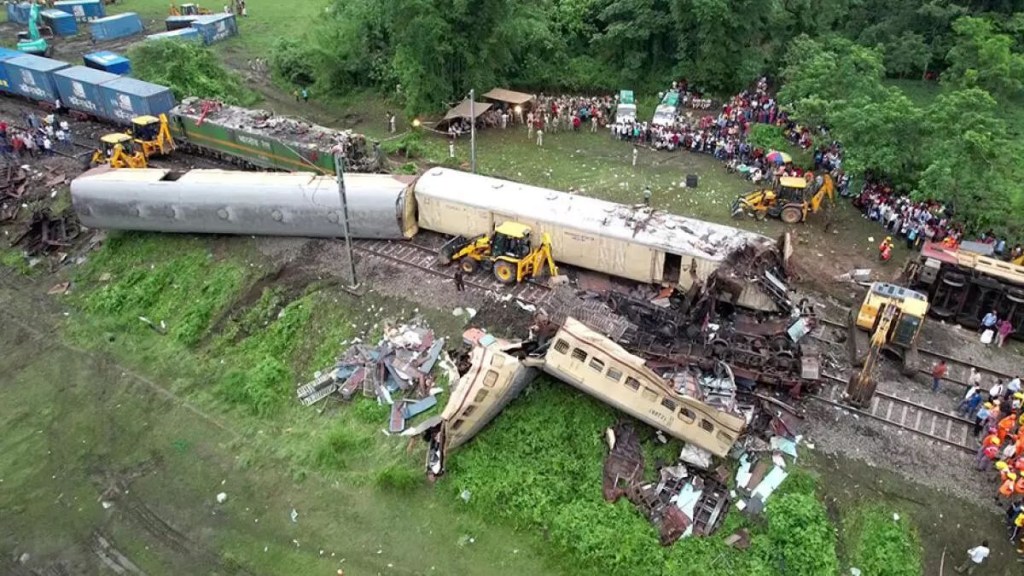The Commissioner of Railway Safety has highlighted that the Kanchanjunga Express accident involving a goods train was deemed “inevitable” due to multiple oversights in managing train operations within automatic signal zones, coupled with insufficient guidance provided to loco pilots and station masters.
Following its investigation into the June 17 tragedy, which claimed the lives of 10 individuals including the goods train’s loco pilot, the CRS strongly recommended the immediate implementation of the Automatic Train Protection system (KAVACH).
The probe revealed critical lapses, such as the issuance of incorrect authorization (T/A 912) for crossing defective signals to the goods train’s loco pilot. Notably, this authorization failed to specify the required speed for safely navigating the defective signals.
‘Accident-in-waiting’
The CRS identified systemic failures within the railway administration, asserting that the incident was a foreseeable “accident-in-waiting” due to improper and insufficiently informative authorization processes.
The investigation further disclosed that subsequent to the signal malfunction, six additional trains, besides the Kanchanjunga Express and the goods train, traversed the affected section, each with varying speeds contrary to prescribed norms.
“In spite of issuing the same authority, different speed pattern was followed by loco pilots,” it said.
Inadequate counselling of loco pilots and station masters
Categorizing the mishap under “Error in Train Working,” the CRS attributed the incident partly to inadequate training and supervision of loco pilots and station masters, which led to misinterpretation of operational protocols in automatic signaling areas.
CRS said “inadequate counselling of loco pilots and station masters about train operation in automatic signalling territory creating misinterpretation and misunderstanding of rules.”
CRS urges KAVACH system adoption
The report underscored the alarming frequency of signaling failures in such zones, citing 208 instances of Signal Passing at Danger from April 1, 2019, to March 31, 2024, resulting in 12 collisions.
“The occurrence of as many as 208 cases of Signal Passing at Danger (red signal overshooting) from 1.4.2019 to 31.03.2024, out of which 12 cases resulted in collision, highlights the limitations of preventive measures taken by zonal railways (counselling of loco pilot/assistant loco pilot, safety drives, etc.),” the CRS said.
Emphasising the urgency of preventive measures, the CRS recommended prioritised adoption of the KAVACH system. It also proposed exploring alternative technologies like AI-based signal detection and GPS-enabled anti-collision systems for locomotive cabs in non-ATP territories.
“This underscores the need for implementation of the Automatic Train-protection system (KAVACH) on top priority. Use of non-signalling-based systems such as Artificial intelligence-based detection of the RED aspect of the signal and providing an early warning to the loco pilot/GPS-based anti-collision systems shall be explored for provision in locomotive cabs across Indian Railways in non-ATP (automatic train protection) territory,” it said.
CRS highlights staffing and coordination issues
The CRS criticised the rail administration for failing to implement recommended procedures during multiple signal failures, suggesting options like adhering to general safety rules, issuing appropriate caution orders, or activating the Automatic Block System. It noted deficiencies in staffing and management responses during the incident, highlighting the inadequate coordination and preparedness of signaling officials.
Finally, the report called for rigorous adherence to automatic signaling protocols and emphasised the need for enhanced oversight and accountability within the railway headquarters to prevent future accidents stemming from rule misinterpretation.
(With inputs from PTI)

